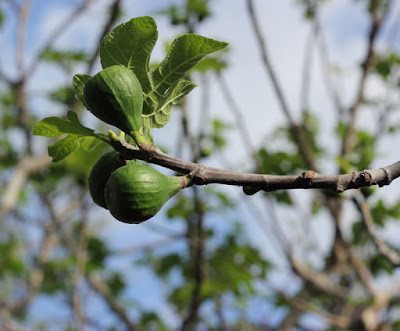BARREN FIG-TREE
TEMPLE CLEANSED
(Road from Bethany and Jerusalem. Monday, April 4, A. D. 30.)
MATT. 21:18, 19, 12, 13
MARK 11:12-18
LUKE 19:45-48
My Summary
In Matthew, Jesus cleanses the temple when he first enters Jerusalem and heals the lame and sick. Then he lodges outside of Jerusalem in Bethany. He curses the fig tree when heading back into Jerusalem the next day, and it withers (Matthew 21).
Mark relates that Jesus was hungry when heading back into Jerusalem, that he saw a fig tree in the distance, went to look for fruit and found none. He adds the detail that it was not the season for figs and curses it.
Odd. Why expect figs in the wrong season? Why bother to curse a tree? It's got to be symbolic. After exploring commentary--yup, I think I'm right, it's symbolic:
"Scripturally, historically, and presently, the fig tree is a symbol of the nation of Israel. Jeremiah, Amos, Ezekiel, Hosea, and Isaiah all liken Israel to the fig tree. Just as the eagle symbolizes America and the bear represents Russia, so Israel is portrayed by the fig tree." -Jon Courson
"This event may have meaning beyond the lesson in faith, however. Many believe that Jesus saw this fig tree as a symbol of Israel at that time. They too were professing to be fruitful, but a closer examination of the nation revealed they were fruitless. By cursing that generation, Jesus was showing His rejection of them and predicting that no fruit would ever come from them. Within a few days, that generation would reject their King and crucify Him. This ultimately led to judgment on that generation. In a.d. 70 the Romans came, demolished the temple, overran the country of Israel, and ended Israel’s political entity (Luk_21:20). Perhaps in cursing the fig tree, Jesus was setting aside that generation. Of course the entire nation was not set aside (cf. Rom_11:1, Rom_11:26)."-BKC
The incident and the disciple's relation of it makes much more sense in light of the symbolism and timing, "within a few days, that generation would reject their King." A few commentaries helped me better understand the timing of fruit on fig trees in this area with regard to Christ's expectations. With such trees, the fruit either comes before or at the same time as the leaves, not after.
"Fig trees in Bible lands produced an early, edible fruit before the leaves appeared. This was a harbinger of the regular crop. If no early figs appeared, as in the case of this fig tree, it indicated that there would be no regular figs later on."-Believers Bible Commentary
 |
| https://lauramakes.com/tag/figs/ |
I was also confused by the remark that "the time of figs was not yet," but Albert Barnes helped me with this:
"Mar_11:13 gives as a reason for this that “the time of figs was not yet.” That is, the time “of gathering” the figs was not yet, or had not passed. It was a time when figs were ripe or suitable to eat, or he would not have gone to it, expecting to find them; but the time of gathering them had not passed, and it was to be presumed that they were still on the tree. This took place on the week of the Passover, or in the beginning of April. Figs, in Palestine, are commonly ripe at the Passover. The summer in Palestine begins in March, and it is no uncommon thing that figs should be eatable in April. It is said that they sometimes produce fruit the year round." -Barnes
Luke tells that Jesus drove the sellers out of the temple and taught there daily.
Commentary regarding Christ's cleansing of the temple:
All irreverence is really, when we get to the bottom of it, unbelief. -Pulpit Commentary, Canon Liddon
"Our first inquiry is—WHAT IS OUR LORD’S VIEW AS TO THE PURPOSE AND END WHICH HE DESIGNS HIS EARTHLY TEMPLES TO SERVE? And this is the answer—“My house is the house of prayer.” He calls us here to pray. The work to which He sets us in the sanctuary is mainly devotional." -Pulpit Commentary
 |
| Map from J.B. Phillips New Testament |
This short (26 seconds) YouTube visual was helpful too.

No comments:
Post a Comment